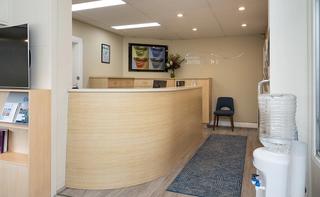
Porcelain & Composite Veneers
What are Porcelain Veneers?
Porcelain Veneers, also referred to as dental veneers or porcelain laminates, are wafer thin shells of porcelain that are bonded to the front of teeth to create a cosmetic improvement and sometimes a bite improvement. Porcelain veneers have successfully improved smiles by making dark teeth look lighter and healthier looking. They can make yellow teeth permanently whiter and gray tetracycline stained teeth look much more natural. Porcelain veneers can make crooked teeth look straight in just a few days. Patient’s can look and feel more confident, more professional and have a wonderfully natural looking smile.
You do not have to have your natural teeth ground down, as porcelain veneers can be totally non invasive without requiring shots.
Porcelain veneers can improve your entire personality by enhancing and adding a spark to your smile and appearance.
Porcelain Veneers can correct:
- uneven or crooked teeth
- teeth that have shapes that are out of proportion
- tetracycline stained teeth that have gray color spaces between teeth
- too much gum when you smile
- yellow teeth that are dark and cannot be whitened or bleached
- teeth that are sensitive can be made much less sensitive
- worn down teeth that make you look old
Porcelain veneers are highly resistant to staining from coffee, tea or even cigarette smoking. Veneers and laminates have a natural appeal to them and last anywhere between 10 to 50 years depending on the skills of the dentist. Porcelain veneers are brushed, flossed and treated just like natural teeth. You should not even know they are in you mouth as they become integrated into your natural tooth structure. The treatment is short as it could take from a couple of days to three weeks to make the veneers depending on the complexity.
How are Porcelain Veneers Applied?
A mould of your tooth is taken for the fabrication of the porcelain veneers that are constructed for each individual tooth. The custom made veneers are then bound to your teeth with a very strong adhesive. There are a huge variety of adhesives and techniques to using these special dental bonding adhesives. The technique of the dentist is critical at this stage to avoid veneers that fall off (they should not). Dental Bonding is important but the patient should be able to see the veneers in their mouth before they are bonded. The patient may want a whiter color or not like the look of the porcelain. The patient needs to be involved in the quality of care.
Advantages of Porcelain Veneers
There are many advantages of getting porcelain veneers. First and foremost they will give your teeth a natural and healthy appearance. Porcelain veneers have an advantage over other cosmetic bonding techniques since they are translucent and have a glass like appearance that is undetectably natural looking. After the laminates are bonded to the surface of your tooth they duplicate the features of natural dental enamel.
Aesthetic restorative procedures can be mastered consistently only if both the clinician and ceramist are intimately familiar with the basic principles of natural oral aesthetics. Understanding aesthetic principles is not limited to only tooth aesthetics but includes gingival [gum] aesthetics and the final aesthetic integration into the frame of the smile, face, and more generally, the individual.
Emerging concepts in biomimetics provide the ability to restore the biomechanical, structural, and aesthetic integrity of teeth. More sound tooth tissue is preserved, tooth vitality is maintained and treatment is less expensive than traditional and more invasive prosthodontics.
Bonded porcelain veneers offer a new restorative solution that balances the functional and aesthetic needs of the anterior dentition. Porcelain’s optimal stiffness, its ideal surface characteristics, and the biomechanical strength achieved through high- performance bonding enable the crown of the tooth as a whole to support incisal or masticatory function. By the same token the optical effects inherent in the tooth and the lifelike features of the porcelain make this restorative approach the ultimate in aesthetic satisfaction for both the practitioner and you the patient
What are Composite veneers?
Just like porcelain veneers, Composite veneers can be used to disguise dark or crooked teeth. They can be created in one appointment.
Composite veneers are made are resin therefore are porous and can stain. Unlike porcelain veneers they only last 4 to 8 years and do require regular maintenance as they don’t have the strength of porcelain veneers.
Results may vary in individual cases. The photo(s) used are stock photos of people who are not patients of Kissing Point Rd Dental Group, employees or affiliates.


